0 Volumes
No volumes are associated with this topic
Chester County, Pennsylvania
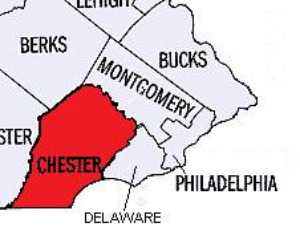 Chester was an original county of Pennsylvania, one of the largest until Dauphin, Lancaster and Delaware counties were split off. Because the boundaries mainly did not follow rivers or other natural dividers, translating verbal boundaries into actual lines was highly contentious.
Chester was an original county of Pennsylvania, one of the largest until Dauphin, Lancaster and Delaware counties were split off. Because the boundaries mainly did not follow rivers or other natural dividers, translating verbal boundaries into actual lines was highly contentious.
 The city of Chester is not in Chester County, but in Delaware County. Originally, that wasn't so, but the split of the two counties occurred in 1789 and old names persist.
The city of Chester is not in Chester County, but in Delaware County. Originally, that wasn't so, but the split of the two counties occurred in 1789 and old names persist.
Chester County, Pennsylvania
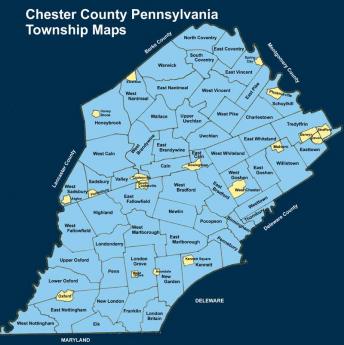
|
| Map of Chester County |
Chester County was one of the four original counties of Pennsylvania, as first laid out by its first white owner, William Penn. Although several parts of Chester County have been cut away, what's left is still quite large. Lancaster County was separated in 1729, and in 1785 Dauphin County was separated from that. In 1789, Delaware County was separated. If you stand in the horse country of Chester County, you still might find it hard to believe anything much has happened in three hundred years. But as a matter of fact, the present population residing within Penn's original boundaries of Chester County would make it the most populous county in the state and growing steadily. Since Philadelphia and Pittsburgh are meanwhile shrinking in population, projected future relationships would strike most residents of Chester County as quite remarkable. Horses, that's what Chester County wants to be all about. Even the mushroom growers of Kennett Square sort of count as part of the horse industry, because mushrooms are grown on horse manure, in the dark. Electronics and steel mills are not exactly traditional, but they reside here, too. As a small footnote, the Lukens Steel Company was recently purchased by an investor named Ross, who lumped it with several other steel mills and then sold the bundle to an owner in India. The consequence is that Chester has a footprint of the largest steel company in the world, or the largest steel company in India, whichever way you wish to style it. Nevertheless, the neighborhood still looks like horse country.
Furthermore, southern Chester County is socially part of the state of Delaware, while western Chester County is thoroughly Pennsylvania Dutch. Up north, the Philadelphia Main Line is building mansions as fast as mortgage originators will allow, and many of them end up paying Chester County taxes. All along Route 202, the central artery of the Great Valley, stretches a burgeoning electronics industry, within which is found Vanguard, the largest investment company in America, or possibly the second largest, depending on temporary quirks of mark-to-market pricing. Chester County presently has the highest average personal income of any county in America. It is far from true that everybody has a horse farm or a trust fund.
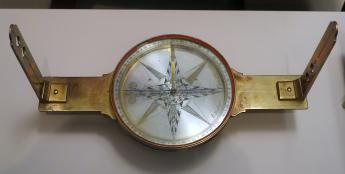
|
| David Rittenhouse's compass |
In a spiritual sense, Chester County horse culture contiguously spreads far beyond even historic outlines of Chester County. The boundaries of southeastern Pennsylvania were laid out with David Rittenhouse's compass, so the rolling hills suitable for horse farming extend into the states of Delaware and Maryland, and of course out into Lancaster and Dauphin counties, without much visible sign of individual state or county. In Europe, by contrast, almost all boundaries are set by rivers and mountain ranges, so the physical appearance of the countryside is apt to change sharply when crossing political borders. In fact, it is possible to say it in reverse: the State of Delaware is mostly Chester County extended, at least in its upper third. Below that lies urban and suburban Wilmington, and below that ("south of the canal") spreads loamy flat farm country, formerly slave country. Maryland divides similarly; an upper third of Maryland's rolling hillsides (sometimes known colloquially as Chester County extended), followed on the south by tidewater Maryland, in turn, followed by the suburbs of Washington, DC. The remnants of Baltimore are mixed in there somewhere, too. When you drive through miles of silent prosperous farms, regardless of highway signs, it is natural to think of yourself in the heart of America.
The one thing Chester County never much warmed to was Universities. It may shock residents of New York City to hear that Chester County never thought much of having its own art museums, classical music, theater performances or opera. However, Chester County doesn't share typical urban dislikes, either. Local speech patterns suggest Appalachian hillbillies and the Pennsylvania Dutch L'il Abners are just like us, just not so rich. Chester County sometimes thinks of itself as nobility, but it isn't Ivy League nobility, it's a country squire. We all like horses, dogs, and guns, we can't imagine why everyone else doesn't like them, too. Chester County has more history than almost anybody; it just doesn't talk much about it.
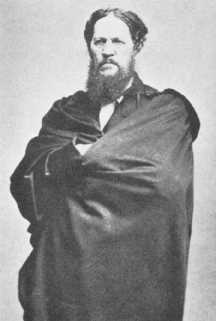
|
| Josiah Harlan |
So let's mention just the highlights: George Washington fought the battle of the Brandywine, the biggest battle of the American Revolution, in Chester County, the Paoli Massacre was long regarded as the second nastiest event of that campaign. A local farmer's son, Josiah Harlan (1799-1871), did what the Tsars and Dictators of Russia and the Kings and Queens of England couldn't do; he conquered Afghanistan. Moreover, he did it single-handedly, making himself King. Even the 350 American Rangers who conquered Afghanistan in 2002 can't match that exploit by this local Quaker boy. The first intern doctor of the first hospital in America (Jacob Ehrenzeller) spent his long life practicing in Chester County. The only President of the United States to come from Pennsylvania (James Buchanan) hailed from Lancaster, not terribly long after it split off from Chester County. In a wry sort of way, it can be said that Buchanan created the Republican Party by almost getting us to annex Cuba. Harrisburg, the present capital of the state, was once part of Chester County. Major portions of both British General Howe's and General Washington's armies left the Brandywine battlefield and swept up the Great Valley of Chester County to Philadelphia and Valley Forge, respectively. Conestoga Creek was once part of Chester County, and Conestoga wagons took many generations of settlers westward to build the new nation; wagons do go pretty naturally with horses. But drive through miles of Chester County today, usually alone through the silent stone barns and rolling grasslands: nothing much seems to have happened except real estate is more expensive.
But then, just drive up Route 202 from Wilmington to King of Prussia, at rush hour. This may be the Great Valley where Washington retreated to Valley Forge, but now it's where employees of the electronics industry ferry children to school, in order to get into the Ivy League, and maybe to shop at fancy stores in King of Prussia. With time out for a recession, it could be wall-to-wall McMansions around here in a generation. It seems almost certain the future will bear little resemblance to the past. It's sort of a pity, it is a great economic opportunity, and it seems inevitable.
Pennyslvania's Boundary: David Rittenhouse, Hero, Lord Baltimore, Villain
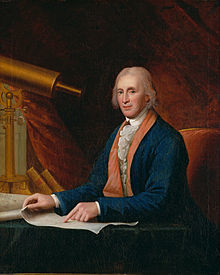
|
| David Rittenhouse |
In the Twenty-first Century, when we know how every American creek and river run, we can see it might have been simple to establish a boundary between the new royal grant to William Penn, and an earlier grant to Lord Baltimore by the then-reigning king's father, Charles I. Essentially: Penn got the Delaware Bay and a lot of wilderness to the west of it. George Calvert, Lord Baltimore, had long held the top half of the Chesapeake Bay and a strip of wilderness to the west of that. Two bays, with two hazy strips of wilderness attached.
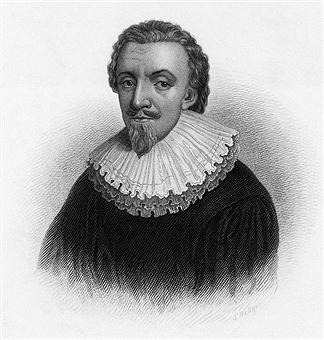
|
| George Calvert, Lord Baltimore |
At what is now Odessa, Delaware, those two bays are only five miles apart; compromise should have settled the issue quickly. Two English gentlemen could have sat down over a pipe and a brew, working something out. However, the English nation was then changing kings, beheading them over matters of religion. A Roman Catholic, Lord Baltimore probably thought an opportunity might emerge from the turmoil if he stalled until matters went his way, since next in line of succession was James, Duke of York, who was a Catholic. But matters fall into the hands of the lawyers when principals of an argument are unable to speak. As we noted elsewhere, in the legal system of the day the last word from the last king was what counted in law courts, accepting any uncertainty about future latest words from future latest kings in order to maintain immediate peace. To lawyers of the time, all this talk about justice, fairness, and geometry was idleness when the nation needed order and stability. So the Calvert family lawyers over the course of eighty years, introduced one specious proposition after another that turned other lawyers purple with rage. Penn's lawyer, Benjamin Chew, beat them at this game, and his mansions in Delaware and Germantown attest to the value attached to this achievement. In other circumstances, posturing might have led to war, as it did in similar disputes with Connecticut. Penn probably knew better, but it takes two to compromise.
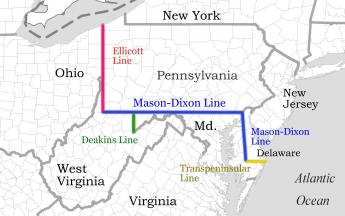
|
| Mason-Dixon Line |
It must be admitted that honest confusion was possible. Sometimes, a line of latitude was a line in the sense Euclid intended: all length and no width. At other times, lawyers and kings were talking about "parallels" as if they were strips, roughly sixty miles wide. If a sixty-mile strip was intended, it was important for a grant to specify whether it extended to the southern edge of the strip, or to the northern edge. But in fact, the state of science in the Seventeenth Century contained uncertainty about both where the strips were, and how wide. And if the grant's language didn't even make it clear whether the parties were talking about strips or width-less lines, eighty years could be a comparatively short time for a court to decide the case. To be fair to Lord Baltimore, many people at the time didn't think these matters were capable of fair solution, so the traditional way of dealing with land disputes was either by force or by craftiness.
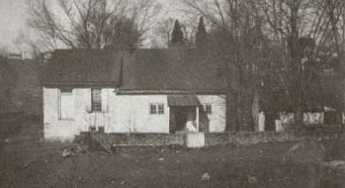
|
| David Rittenhouse Birth Place |
In William Penn the folks from Maryland were, unfortunately, dealing with a friend of the King, who had one of the most brilliant mathematicians in Western civilization as his adviser. David Rittenhouse may have been born in that little farmhouse you can still visit on the Wissahickon Creek, and made his living as a clockmaker, but his native talents in mathematics, astronomy surveying, and instrument construction were so deep and so varied that later biographers are reduced to describing him merely as a "scientist" and letting it go at that. If you want to sample his talents, spend an hour or two learning what a vernier is, and then see if you could apply that insight, as he did, to a compass. So, as it turned out, Rittenhouse was able to describe a twelve-mile circle around New Castle, Delaware, construct a tangent that divides the Delmarva's Peninsula in half, and match it up with an east-west line we now call the Mason Dixon Line. When they finally got around to laying these lines on the ground, Mason and Dixon cut a twenty-four-foot swath through the forest, using astronomical adjustments every night, and laying carved marker stones every fifth of a mile for hundreds of miles. The variation from the line devised by Rittenhouse was at most a fifth of a mile off the mark; the intersection with the north-south line between Maryland and Delaware was less successful. The survey by Mason and Dixon was not quite completed to the Ohio line because the Indians, curious at first, eventually became wild with suspicion at such behavior, particularly the part about going out and aiming cannons at the sky every night. It seems likely that George Calvert, Lord Baltimore, had no more confidence in this madness than the Indians did.
So, the next time you take the train from Philadelphia to Washington DC, reflect that strict reading of the words in the land grants did admit the possibility that your whole trip could either have been within the State of Maryland, or else in the Commonwealth of Pennsylvania, depending on whether lawyers, or scientists, had triumphed in this dispute. Since the Mason Dixon Line later divided not merely two states, but two violently opposed cultures, Rittenhouse must stand out in the history of one of those people who were so smart that most people couldn't understand how smart he was.
Boundaries of the Grant of Pennsylvania
The Quaker Who Would Be King
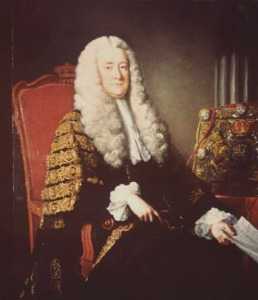
|
| Philip Yorke, Earl of Hardwicke |
When the Duke of York was within hours of being banished, he told his agent Sir John Werden to give the contested strip (now the state of Delaware) to Penn, but save out the town of Newcastle with a twelve-mile strip of land around it. Werden wrote that into the charter with a proviso based on the idea that the fortieth parallel was to the south of Newcastle, when in fact it was fifty miles north of it, and could not possibly conform to the stated boundaries. Both Penn and Baltimore learned the true situation in a year or two, and both attacked the other for dissembling ignorance, each seeking to take advantage of implausible arguments. What in fact they both discovered was that if the dividing line could be pushed a few miles south, Penn would acquire the mouth of the Susquehanna in the Chesapeake Bay, while if it went north a few miles, Maryland would acquire most of Philadelphia. Lord Hardwicke worked out a reasonable compromise which, while ignoring some plain language in the documents, eventually resulted in the Mason-Dixon line which is now reasonably comfortable for everybody, although first subjected to another two decades of wrangle.
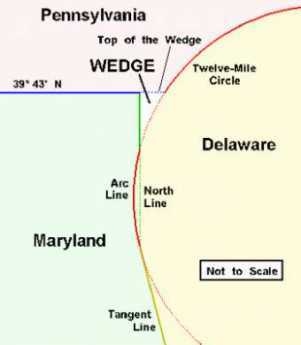
|
| Delaware Wedge |
Even part of the eventual compromise, a semicircular northern border, didn't come out right, resulting in a wedge of no-man's land. Landowners didn't enjoy paying disputed taxes, so they held up the settlement of the wrangle into the Twentieth Century. Eventually, the U.S. Supreme Court cut the wedge into two pieces, giving one piece each to Pennsylvania and Delaware. Meanwhile, disputes continued which had their basis in the way the semi-circular line was plotted out on the land. The surveyors ran 120 straight-line radii outward from the courthouse tower in Newcastle, and then connected the ends. Obviously, that resulted in 120 straight chords instead of a smooth semi-circle, and a couple of bulges had to be accommodated where the circle grazed other straight borders. The semi-circle crossed the Delaware River, so New Jersey helpfully abandoned its portion, only to regret its decision later when toll bridges were constructed, and ship channels deepened.

|
| King Charles I |
Two major societal changes took place between 1632 -- when Charles I granted the proprietorship of Maryland to the first Lord Baltimore -- and 1776 when all American real estate changed its rules. The first change was that the Delaware Bay morphed from a swamp into settlements of people; settlers came into possession. The second evolution was to the current view that if you sell some real estate it is no longer yours; in earlier eras, everything belonged to the king, who could take it away and give it to others as often as he pleased. In legal terms, the last king had the last word. Although acres of parchment were scribbled by lawyers pro and con, these considerations are what make clear how Lord Baltimore could hold the unchallenged legal title for fifty years to everything up to the fortieth parallel, but then have a court take away thousands of square miles. A land which was to become the three lower counties of Pennsylvania was given to William Penn by the Duke of York in 1682, using some flawed documents and only fully enjoyed by Penn's heirs for six years until they morphed into the new State of Delaware. From 1684 to 1769, legal ownership was a matter of continuing dispute. The exasperated Lord Chancellor (Hardwicke) in 1750 declared the case as one "of nature worthy of the judicature of a Roman senate rather than of a single judge".
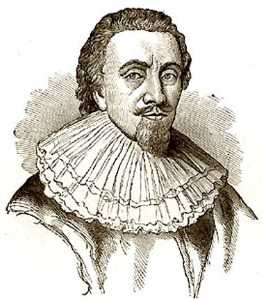
|
| Lord Baltimore |
Lord Baltimore had been given "unsettled" land, occupied only by savages. William Penn's lawyers struggled to prove the Dutch had settled the area before 1632, while Baltimore's lawyers sought to prove that pirates and wandering fur traders don't count, nor do villages of thirty people who were wiped out by the Indians. By the Doctrine of Discovery, taking land from pagans was encouraged, but taking land from Christians required special formalities. Since this Doctrine dates back before there were Protestants, it might have been pertinent to inquire whether the Dutch should be regarded as pagans, as the Spanish surely did when they suppressed Dutch independence in the Eighty Years War, ending in 1648.
Lord Baltimore advertised land along Delaware for sale to settlers while the matter was still under litigation. That was the foulest play said Penn, a weak argument to make if litigation was intentionally pursued for a century.
Maryland favored the Catholic cause, so it seemed plausible for them to want to stall, hoping the Catholic Duke of York would ascend to the throne. Under the new King James II, however, Baltimore seemed unlikely to prevail that the same person, as Duke of York, really didn't own the land he was trying to give to William Penn. So of course, Lord Baltimore claimed he never stalled.
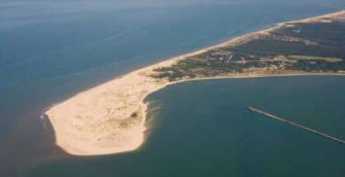
|
| Cape Henlopen |
And by the way, ocean currents moved Cape Henlopen a mile or so southward, but the real boundary problem was that common usage over the centuries confused Cape Henlopen with Fenwick's Island (to which it is usually attached by a thin barrier island), making an implicit difference in the Maryland/Delaware ownership of the corresponding strip of land at the southern border of the State of Delaware, a matter of a hundred or so square miles.
And all of this confusion was merely about the borders of one of the smallest of our fifty states. The political manner in which Delaware became a colony without a charter to the King, and became a state by gradual and mystifying degrees separate from the other counties of Pennsylvania are other complicated stories. Never mind the reasons Delaware remained in the Union during the Civil War, even though it also remained a slave state.
With gratitude to the memory of Dudley Cammett Lunt 1896-1981, whose books are a most readable but scholarly analysis of this complicated history. In particular, The Bounds of Delaware and, for the Mason-Dixon Line, Taylor's Gut in the Delaware State are recommended. The courts rejected arguments that the land was essentially wilderness when Lord Baltimore acquired his patent, and history has been sympathetic to Penn, the winner. The contention was the Dutch owned the land by right of discovery ( a Doctrine applied to land ruled by pagans by Pope Nicholas II in 1454), while the Duke of York later took it from the Dutch by surrender to force of arms -- another legally benign method of acquiring sovereignty. However, Lunt points out that a far more significant issue was the southern border of Pennsylvania in Penn's original grant, which asserted geographical impossibility to replace Maryland's plain and simply defined boundary. History has tended to regard this as understandable error, and subsequent legal quarrels to have been perpetuated by William Penn's greedy heirs. However, Lunt seems to reveal his own opinion of the affair by ending his book with a July 31, 1683 quotation from a letter by William Penn to Colonel Thomas Tailleur:
I, finding this place necessary to my Province and it ye Presence of Ld. Balt. was at Law, civil & common, I endeavoured to get it, & have it, & will keep it if I can.
Defeat and Disaster: Philadelphia Falls to the Enemy
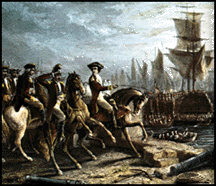
|
| Howe |
Helen of Troy had launched a thousand ships. Lord Howe only launched four hundred and thirty, but they were bigger. It is estimated a thousand oak trees were cut down to build just one man o' war. To repeat what happened next, this flotilla was parked in lower New York harbor while forty thousand redcoats conquered Brooklyn Heights, Manhattan, Washington Heights, Perth Amboy, New Brunswick, Princeton, Trenton -- and then Washington promptly made fools of Howe and Cornwallis, at Trenton, Princeton, New Brunswick. Howe, and Cornwallis, in particular, were raging mad. The first year of the two-year siege of Philadelphia was over, and at half-time, the British team was popped up.

|
| Lord George Germaine |
The grand plan laid out in London by Lord Germaine was for Howe to capture New York, and maybe Philadelphia if it would be useful, while Gentleman Johnny Burgoyne took an army from Canada along that giant cleft in the earth which starts at the St. Lawrence River, down Lake Champlain, then down the Hudson from Albany to New York. The Hudson is very wide, and the British Navy would have no trouble sailing upriver to Albany, landing an army to meet Burgoyne coming south, with the effect of cutting New England off from the rest of the Colonies. Burgoyne got his orders in London shortly after Howe's January disaster in Trenton arrived in Quebec in May and started on his campaign June 20. Nothing dilatory about him. Howe, however, had six months to get to Albany before that, and several months more before Burgoyne would get to Saratoga, tromping through the woods and black flies. From Staten Island, it might have taken Howe ten days to sail to Albany in plenty of time.
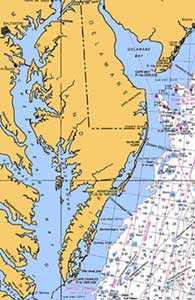
|
| Chesapeake Bay |
Instead of that, Howe solitary and without advice, decided to take Philadelphia. Although the British never dwelt much on the fine points, the actual rebellion was only taking place in New England at the time the fleet set sail. It was the arrival of the fleet which triggered the Declaration of Independence, not the other way around. Lord Howe therefore probably felt some justification in revising the agreed plans and orders under which he set sail. As has been described already, the initial foray to Trenton ended embarrassingly. So, the capture of the enemy capital would now help people forget Princeton, and it would be sweet to whip Washington.
Unfortunately, they wasted a lot of time doing it. Finding Delaware too well fortified, and almost as snaggy as Henry Hudson had found it more than a century earlier, he sailed all the way to Norfolk, came up the Chesapeake and landed at the head of Elk, and marched for Philadelphia. The Brandywine Valley has deep sharp cliffs off to the right, so Cornwallis was sent off to the left as a flanker past Dilworthtown while Howe attacked Washington head on at Chadd's Ford. It was to be the largest battle of the whole Revolutionary War. When Washington found himself facing encirclement, he had to order a withdrawal. To skip a few events now memorable to the Main Line suburbs, Philadelphia was essentially then occupied without a further fight, with the British set up their defenses at Germantown, seven miles from the center of town. Three weeks later, Washington attacked Germantown in a three-pronged assault that mainly failed because two of his formations attacked each other in the fog. That was October 4, 1777. The news soon reached them that Burgoyne had surrendered the other British army --starving in the woods -- at Saratoga, New York on October 17. Howe had in effect abandoned Burgoyne in order to take Philadelphia, but it was probably as much a result of getting drawn into a tangle, as a single decision to disregard the grand plan.
In retrospect, it was quite a bad choice. All the world -- and the King of France in particular -- could see that Washington had beaten Howe at Trenton and then Gates and Benedict Arnold had soon beaten Burgoyne at Saratoga. General Gates, of course, was in charge at Saratoga, but Arnold was the flamboyant hero. Adding to his earlier exploits in Quebec and later providing the captured cannon of Ticonderoga for General Knox to drag over the mountains to Boston, thereby allowing Washington to drive the British fleet to safer distances, Arnold now essentially won two more battles at Saratoga. The first was to defeat Leger, who had been sent down Lake Ontario to come back up the Mohawk Valley to Albany. Then, turning his troops through the woods, Arnold joined Gates at Saratoga and defiantly led the charge that smashed the British line, when Gates would have been satisfied with containment. Arnold, like Alexander Hamilton, was a flamboyant man after Washington's heart.
Meanwhile, Howe settled down to enjoy winter at Philadelphia. His court jester and chief entertainer were Major Andre, who took wicked pleasure in using Ben Franklin's Market Street home as his own. There was additional satisfaction in knowing that Washington was freezing at Valley Forge.
Furniture for the Horse Country

|
| Douglas Mooberry |
Low-end furniture for America is now mostly made in China, and seldom made of wood. Truly American cabinet making tends to be high-end, and high priced. That tendency goes to some sort of extreme around Unionville in Chester County, where a 25-year old company named Kinloch Woodworking holds pride of place. The owner, D. Douglas Mooberry, picked the name Kinloch at random from a map of Scotland, but his selection of southern Chester County was not an accident. The influence of nearby Winterthur has infused that whole region with an interest in fine furniture craftsmanship, and museums like the Chester County Museum and others throughout the nearby Pennsylvania Dutch country provide an ample source of authentic pieces to serve as examples. There's one other factor at work. As Doug Mooberry quickly noticed, people with money usually have lots of it. There really is a market for $28,000 tall case clocks, $18,000 highboys, and $12,000 tables -- if you can convince people in Chester County you are really good.
Although this 12-person company repairs antique pieces, it does not make exact reproductions. It produces new pieces in the old style of the region, based on careful analysis and evaluation of museum pieces from earlier times. Kinloch once aspired to equal the quality of the early artisans, but now aspires to surpass them in quality of materials and workmanship. The more conventional stance of fine artists is to attempt to excel in today's current style, whatever that may be, probably "post-modern". Kinloch artists, however, choose to excel in the style of a long-past era, taking care not to claim the product is antique. Artisans grow up in cooperative clusters; there's a world-famous veneer company nearby and a pretty good hardware company, although the best craftsmen of furniture hardware are still found in England.
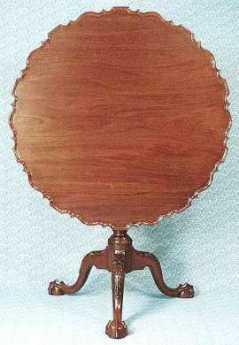
|
| Chippendale Table |
The characteristic style of Chester County furniture in the Eighteenth Century was a mixture of two neighboring cultures, Queen Anne, Chippendale, ball and claw Georgian style of Philadelphia; and the "line and berry" inlay style of the Pennsylvania Germans. If carefully executed, this hybrid style can be very pleasing, and you had better believe it requires painstaking craftsmanship. Others will have to explain the significance or symbolism of intersecting hemi-circles in the lines, and the inlaid wood hemispheres, the berries, at the end of the lines. But the technical difficulty of laying strips of 1/16 inch wood in curved grooves only a thousandth of an inch wider, or the matching of 3/8th-inch wood hemispheres into hemispheric holes gouged out of the main piece -- making the surfaces of the inlays perfectly smooth -- is immediately obvious to anyone who ever tried to whittle. Ultimately, however, true artistry lies in combining two unrelated styles without producing an aesthetic clash. By the way, you would be wise to wax such furniture once a year.
The factory is on Buck and Doe Run Road, and here's another culture clash. At one time, Lammot du Pont cobbled a 9000-acre estate out of several little country villages. In 1945 it was sold to the Kleberg family of Texas, the owners of the King Ranch. Robert Kleberg was an admiring friend of Sam Rayburn but treated the oafish Lyndon Johnson as his personal political gofer. From 1945 to 1984 Buck and Doe was used as one of several remote feedlots for Texas Longhorns bred to Guernseys, the so-called Santa Gertrudis breed. Originally, Texas cattle were seasonally driven to Montana for fattening, then on to railheads for the stockyards. As farmers began to build fences interfering with the long drive over the prairies, it became cheaper to fatten cattle closer to the markets. So satellite feedlots like Buck and Doe Run were developed. You can pack more cattle in a rail car when they are younger and smaller, and advantage can be taken of price swings by suppliers who are close to the market. In this case, the markets were in Baltimore. Since the King Ranch is larger than the state of Rhode Island, such 9000-acre farms were pretty small operations in the view of the Texas Klebergs, an opinion they did not trouble to conceal from the irritated local gentry. The point was even driven home in high society circles by holding large parties at Buck and Doe Run, allowing guests to wander around the roads, unable to find the house of their host even though they had been on his property for most of an hour. In 1984 the Buck and Doe was sold to Art DeLeo, who is busily converting it into a nature conservancy.
Doing Well, Doing Good.
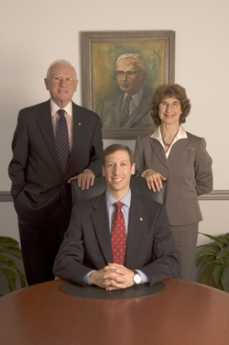
|
| Lynmar Brock |
Lynmar Brock is a Quaker, so what he does is surprising. He lives on a farm, but is Chairman of the Board of a food distribution corporation. He's also chairman of several other boards. He's written several books, and among them, a novel Must Thee Fight? relates the tribulation of one of his pacifist ancestors who nevertheless became a soldier at the Battle of Brandywine. The theme of this emotional conflict parallels the author's own struggle over being a conscientious objector who ultimately volunteered for the Navy because he felt he could not stand by while others fought his battles for him. The face of the soldier with a musket on the book jacket is his own.

|
| Rotary Seal |
When American forces recently entered Afghanistan, a great many people were forced to become refugees. Lynmar Brock was on the board of Rotary International, where a decision was made to provide relief for the refugees, and Mr. Brock flew over to lead the effort on the ground. Rotary raised $2 million almost immediately, and the task was to translate the money into something the refugees really needed. Since "shrinkage" is a common fate for refugee shipments, Rotary bought locally. They were able to distribute 83,000 pairs of shoes, 53,000 blankets and similar quantities of a number of other basic needs. Ultimately, the three-year effort raised $115 million and distributed items in the millions. It was important to give the goods to the local tribal chief, who then redistributed to the members of the tribe. To give it directly would undermine the authority of the chief, very likely provoking him to interfere with it. Accordingly, it is essential for relief workers to make friends with the chieftains, and it is essential to avoid the appearance of being a sap. All of the clothing was stamped with a big indelible yellow Rotary Seal; if it turned up in the black market, it would still be obvious what its source had been. At the same time, it was essential for donors not to appear to be soldiers. One of the missions of the group was to show the Afghans that Americans were real people who cared, and not all were soldiers. That they were successful in this way was brought out by one tribal chief coming forward and saying, "Teach us English. It's the language of the world."
Some influential Rotarians are active in American ophthalmological circles, and arranged to have American eye surgeons extract a great many cataracts from Afghans otherwise destined to a life of blindness. Since the Taliban routinely poisoned the wells, it was vital that farmers like Lynmar Brock were able to show how to repair or replace the local water supply. It might have been better to replace opium farming with tomatoes, but a compromise was made to replace opium with marijuana. That's an improvement, of sorts. The danger inherent in this work must not be shrugged off. All vehicles of foreigners were preceded and followed by at least six local soldiers. As the cavalcade moved from one tribal area to another, the soldiers were changed for soldiers of the new tribal area; their loyalty just had to be trusted. And, indeed, the co-chairman of the committee was mysteriously murdered one day.
The Rotarians return home full of praise for the U.N. field workers, mostly European, who are actually engaged in foreign relief work. The headquarters staff back home at the U.N. are described with only a shrug that speaks volumes, but it is useful for us all to keep the distinctions in mind.
Lynmar says it's great to be home. In his busy life there's work to be done on the farm, and in his corporation, and writing another novel. And there is supervision also needed for the Rotary efforts in the Ivory Coast. It's not completely certain, but sometimes he actually gets some sleep.
Gardens for Posterity

|
| J. B. Garden |
We must be indebted to "Several Anonymous Philadelphians" who wrote a book published in 1956 called Philadelphia Scrapple, now out of print but subtitled "Whimsical Bits Anent Eccentricities and the City's Oddities." The Athenaeum librarian has carefully penciled in the names of Harold Donaldson Eberlein and Mrs. Henry Cadwalader as the probable authors of this work, and it's likely that is the fact of it.
Chapter XIV of "Philadelphia Scrapple" discusses a class of notable public gardens not designed to be show gardens, but originally the hobbies or passions of the original owner for private enjoyment, and later were opened to the public. These abound in Philadelphia, sometimes somewhat decayed, often truncated as the land was sold off, but constantly increasing in interest as the boxwood, trees, and shrubs continue to grow in size and rarity. The Anonymous Philadelphians have classed these lovely and somewhat unknown places as "Gardens for Posterity". Quite often, the estate houses to which they belong are better known than their gardens, and the original owners just regarded their gardens as a normal part of the house.
While there are dozens of such places, the more notable ones are Grumblethorpe in Germantown, The Grange in Delaware County, Andalusia along the Delaware, and two famous gardens in decrepit neighborhoods along the lower Schuylkill, John Bartram's Gardens and William Hamilton's ("Woodlands"). There is a record that the Continental Congress once adjourned to visit Bartram's garden, and Hamilton's garden is mentioned by several famous Revolutionary figures since it was on what was then the main route from Philadelphia to the Southern Colonies. John Wister's 1744 garden at Grumblethorpe was 188 by 450 feet in size; some of the boxwood have had a long time to grow.

|
| Pennsylvania Hospital |
To these should be added the hospital gardens at the Pennsylvania Hospital, at Friends Hospital along Roosevelt Boulevard, and the garden of Chester-Crozier Hospital, all of which are especially spectacular in early May when the Azaleas are in bloom. Just about every surviving mansion of colonial rich folks had such a garden at one time.
And tucked away behind many current mansions are lovely gardens that are considered to be just as private as their living rooms. While they are proudly displayed to friends, strangers knocking at the garden door would be considered the height of rudeness. It will take another generation or so for them to be thrown open to the public. By that time, who knows what state of repair they will be in.
For a unified access point for 30 gardens in the Philadelphia area, try www.greaterphiladelphiagardens.org
Dog Days
Teddy Roosevelt was a great conservationist, promoting the outdoors life, establishing the National Park Service and so on. At the same time, the walls of Sagamore Hill his home on Oyster Bay were covered with the stuffed heads of big game animals he had personally shot for no better reason than it pleased him to shoot them. This paradox is a convenient symbol of the mixed-up ideas and conflicted attitudes of the public at large about animals. We love them, but we also eat them for dinner.
The two sides of this tension have at their extreme some pretty rich nut cases, or some pretty nutty rich folks, however, you wish to style them. One woman has bought half the country of Paraguay for a nature preserve. On the other extreme, it is said that one wealthy Philadelphia lady has contributed enough money to attract the solicitude the Governor, in the interest of animal rights legislation. Since his political enemies call him "Fast Eddie", that isn't his usual image. It is rumored that he loves his pet terrier, but the center city cynics gathered around lunch tables on Camac Street surmise that his really influential friends could be real estate developers. This all does require a little explaining, which is a full-time occupation in some circles.
Jim Scharnberg was entertaining Inmates the other day about his almost full-time avocation of hunting rabbits in Chester County with a pack of French hounds. Hounds, mind you, not dogs. There are thirty clubs in Chester County alone concentrated on packs of hunting hounds, not to mention all the other counties in the state, and not to mention the hunters on horseback, the fox hunters, the deer hunters, and lots of other kinds of hunters, sometimes with but mostly without guns. Most of these groups have frequent outings together in the countryside, followed by jolly dinners and gatherings, and with newsletters, websites, intermarriages and lots of other associations. Social scientists would call these networks, a trendy phrase, that..
To illustrate how easily networks are formed between hound lovers and politicians, Jim tells the story of living in Manhattan near Gracie Mansion, with his hounds of course. Hounds have to be walked, you see, and the New York police are not particularly friendly to the idea, nor are other inhabitants of the skyscraper canyons, who promote pooper scooper laws and encourage police harassment of hounds. One evening a dog belonging to a native New Yorker was attacked by 27 East River rats. Jim's hounds were unleashed, the dog was rescued. It turned out to belong to Mayor Lindsay, who was quickly persuaded to create special privileges for hounds in Carl Shurtz Park and other East Side grasslands.
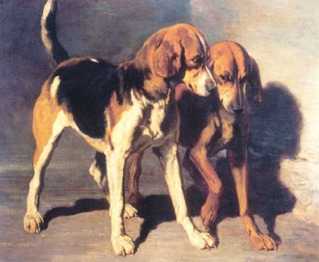
|
| French Hounds |
Some members of hound packs are into the whole thing, as Jim is, but most members merely enjoy an excuse to wander in the outdoors with convivial company, or else enjoy the parties afterward; some people just like to write newsletters and send out meeting notices. Everybody likes to talk, that's one sure thing. These things flourish in the exurbs, the farm areas just beyond the edge of development. In Chester County, such farmland is quickly disappearing at the rate of 13,000 acres a year as real estate developers find it is cheaper to build in the countryside than where you have to tear down old buildings to build new ones. Inevitably, the people whose ancestors started the farms 300 years earlier are upset at seeing the old place go. There's an economic issue as well, because farmers need local canneries and wholesalers to take their farm products; these support systems tend to wither as farming gets sparser. And the new neighbors are not accustomed to farm sounds or farm smells. The idea of living next to a pig farm is not softened by the knowledge that the pig farm was there first. Perhaps you get the idea; conflict is how politics gets into it, and these are the networks who will prostrate themselves in the middle of the highway to preserve their heritage. All it takes is a couple of rich ladies to get excited enough to donate lobbying money, and wondrous inanities can get taken seriously. There is now a bill before the Pennsylvania Legislature which in other times would be referred to as a "tickle" bill, one of ten thousand annual bills submitted by legislators to placate constituents, but widely observed never to go anywhere. But put some serious money behind a tickle bill, hire a few consultants who know exactly which levers to pull and which clauses to include for support, and you could have a law to air condition all dog kennels, thus making Pennsylvania the laughing stock of the country's legislative circles. There can be rules governing the size and cleanliness of dog runs, rules about Fido's required breakfast content, and rules to sterilize every domestic animal so that in one generation we will be animal free.
Grown ups are actually saying such things, and legislators are growing afraid to oppose them. Back home in the real estate office, everybody can be all smiles. Because this is how you can get some nice zoning changes if you play your cards right.
Serpentine Rock From Serpentine Barrens
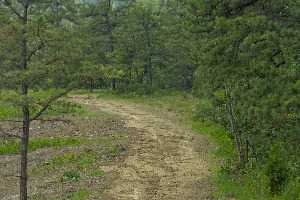
|
| Barrens |
Even in pre-revolutionary Colonial days, it was recognized that patchy areas of Chester and Lancaster counties were covered with twenty-foot stunted evergreens instead of two-hundred-foot oaks. They were "barrens", resembling the pine barrens of central New Jersey. In time, these barrens were particularized as Serpentine barrens, out of a recognition that this stunting of vegetation was somehow associated with greenish stone in the bedrock. So, the serpentine barrens in time became serpentine rock quarries, but they seem somehow less barren now that surrounding deciduous forests have been cut down to make nice farmland. The greenish stone was a novelty, especially because it was usually (but not invariably) soft sandstone and easy to quarry, and the bedrock was only an inch or so under the topsoil, or even appeared on the ground surface as outcropping. These qualities made serpentine a popular building material, but in retrospect, it should have been more apparent that sandstone crumbles easily, and what can stunt tree growth probably wasn't very good for you.
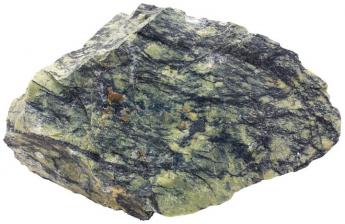
|
| Serpentine Rock |
Well, the green color comes from chromium salts. Sometimes the greenish color is diffused throughout the volcanic rock, but more commonly concentrated in green veins "snaking" through sandstone. Diffuse is better for building because the greenish intrusions create fracture lines in response to acid rain. In modern times, we mostly think of chromium as imparting a shiny look to plated auto bumpers. Some automaker was once quoted as saying he sold more cars using $10 worth of chrome than with $100 worth of engineering. That's metallic chrome because central to the definition of a metal is that it looks shiny. Even high school chemistry scholars can tell you it is a "salt" of chromium, the chromic ion, which imparts a greenish tinge when dissolved in water. So, chromic salts dissolved in the local water are what dwarf the vegetation of a serpentine barren, not chromate (which is yellow), and not metallic chromium (as in auto trim). So, although one might suppose otherwise, a few years ago when local builders started up modern quarries of the serpentine rock, the environmentalists of Chester County were up in arms. Demonstrations were held, editorials are written, politicians hectored. The Serpentine Barrens was a local treasure, requiring legal protection; protective ordinances were demanded.

|
| Building construction with Serpentine Rock |
Although building construction with the serpentine rock had a considerable flurry in the late 19th Century, the crumbly nature of sandstone caused the disappearance of all but a few examples. A building in boathouse row on the Schuylkill, a pre-revolutionary house on the Brandywine battlefield, College Hall on the campus of the University of Pennsylvania, pretty much comprise the notable surviving examples. But in a certain way, the Serpentine buildings do sort of define Victorian Philadelphia.
California is not within the intended scope of Philadelphia Reflections. However, it probably should be mentioned that Serpentinite is the official California rock, as would be natural for a substance which composes about 2000 square miles of its bedrock. It's green in color, but has high magnesium content, and seems to originate with the grinding of tectonic plates as they throw up mountain ranges, with attendant earthquakes. California also has serpentine barrens, but local geologists blame that harmful vegetation effect on magnesium competing with soil calcium (rather than the less notable chromic ions in West Coast serpentine). We're getting into some pretty fine distinctions, here. Pennsylvanians will probably be content to know we found ours first, that it had a flurry in Victorian architecture, and it's just a bit quaint. And, that it doesn't pose a significant risk for asbestos poisoning. A California geologist, in defending their state rock honor, recently proclaimed there was a greater statistical risk of dying from their state animal (the grizzly bear) than from their state rock.
REFERENCES
| The Pine Barrens: John McPhee: ISBN-13: 978-0374514426 | Amazon |
Military School
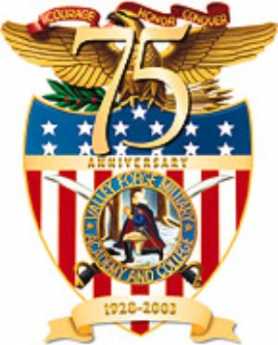
|
| VFMS Crest |
In the middle of the pacifist Quaker farm region, in fact in the middle of William Penn's Quaker Welsh Barony, sits Valley Forge Military Academy. Its location seems even stranger when you consider the nearest town, within easy walking distance, is Wayne, PA described by David Brooks in Bobos in Paradise as the East-Coast epicenter for yuppie education-based elitism, with all its air of entitlement. In fact, Brooks does not mention the Academy once in his three hundred page book about the town. What is VFMA and why is it located where it is? Three names, Baker, Mellon, and Annenberg pretty much explain it. Lieutenant General Milton Baker, a great friend of the Eisenhower family, was passionate about Valley Forge, its history, its parks, its military hospital, its renovation, and its preservation. If Baker founded a school (in 1928), it was going to be here. The money was Mellon and Annenberg money, but Baker was their man.
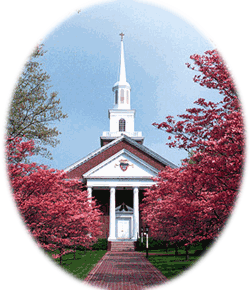
|
| Military school |
Military schools are now in a period of decline. A flurry of a building after the Civil War created about 600 of them, in recognition that the North nearly lost the Civil War to the Confederate States who had a much stronger military tradition, especially in Virginia. It's therefore not surprising that Valley Forge wanders from Southern traditions, and is consciously modeled after Sandhurst, the British Royal Military College. Valley Forge competes with Canada, Australia and Great Britain for foreign students, while the Southern schools are more provincial. There seem to be two main reasons to send your son to a military boarding school.
The first is the tradition of military aristocracy, traceable in a sense to feudalism and the Knights of the Round Table. There's little patience with a politically correct speech in the military, who readily tell you that many rich families encourage their daughters to marry career military officers, as a way of strengthening loyalties between these two power groups. During the formative years of the American republic, the resounding emphasis was placed on having no standing army. That was a cloaked way of restraining a military aristocracy and seems to have provided the main reasoning behind the constitutional Second Amendment, which projects a general right of all citizens to bear arms. It follows the model of Switzerland where military service is universal, as contrasted with limiting firearms to specialists, whether police or military. If that was the goal, it seems to have been effective; military elites now seem most appealing to foreign cultures, like Latin America, Korea, Saudi Arabia. Tony DeGeorge, the current president of Valley Forge, tells of an astounding phone call from one Saudi prince, who responded to an alumni fund-raising appeal by offering to buy the whole school. The Saudi noticed one supposes, that "Storming' Norman" Schwarzkopf, the hero of the First Gulf War, was an alumnus of Valley Forge.
The other main reason to send your son to military boarding school, is because he's too unruly to handle at home. Here is another seemingly delicate matter the school makes no bones about. All new entrants must spend six weeks as "plebes", enduring a ferocious hazing discipline that weeds 'em out. The solution to cell phones and Internet games is to forbid them. Valley Forge confronts the matter of recreational drugs head-on. All students are subject to random drug testing, and a positive test means get off the school grounds -- permanently -- within four hours. The exercises program is not only mandatory, but it is also rigorous beyond description. The result is that fifteen alumni are currently playing professional football in the NFL, the polo team is regularly the national champion. Somewhere General Baker got the idea that playing music helps your mathematical ability, so every single 9th grader plays the violin. The marching band is internationally famous, and by gad, it better stay that way. Only about a third of the graduates go on to a lifetime military career, but another third of the alumni are CEOs of companies. Even what happens to the remaining third bears some thought.
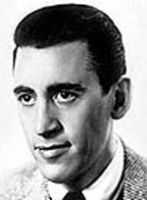
|
| J.D. Salinger |
J.D. Salinger and Edward Albee were both alumni of Valley Forge Military Academy. True, General Baker told Salinger that The Catcher in The Rye was rubbish, and one need not speculate much on how he would have reviewed Who's Afraid of Virginia Woolf? Nevertheless, it cannot be denied that the collision between these two social misfits and the plebe hazing experience contributed significantly to the depth and power of the serious literature they produced. It is not easy to name two alumni of Andover, Exeter or Lawrenceville who have contributed as much to 20th Century American fiction. Salinger and Albee hated the place, but it made them what they became. "Whatever that was," you can almost hear the other two-thirds of the alumni mutter.
In a day that echoes No Child Left Behind, it is a little hard and it is certainly politically incorrect, to give this devil its due. But all Armies live by the slogan, that if you must take an objective, you must take some casualties.
Kenneth Gordon, MD, Hero of Valley Forge
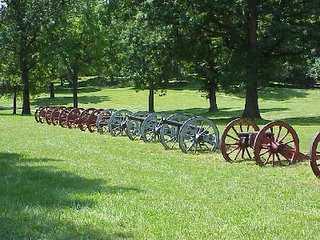
|
| Valley Forge |
There's no statue of Ken Gordon at Valley Forge National Park, although it would be appropriate. No building is named after him; it's probable he isn't even eligible to be buried there. But there would be no park to visit at Valley Forge without his strenuous exertions.
One day, Ken's seventh-grade daughter came home from school with the news that the father of one of her classmates said that Valley Forge Park was going to be turned into a high-rise development. That's known as hearsay, and lots of things you hear in seventh grade are best ignored. But this happened to be substantially true. At that time, the Park was owned by the Commonwealth of Pennsylvania, and Governor Shapp was finding the upkeep on the Park was an expense he needed to reduce. The historic area had two components, the headquarters area, and the encampment area. One part would become high-rise development and the other would become a Veteran's Administration cemetery. Although any form of rezoning has the familiar sound of politics to it, Dr. Gordon (a child psychiatrist) had the impression that Sharp was mostly interested in reducing state expenses, and had no particular objection to some better use of the historic area. At any rate, when Gordon went to see him, he said that he would agree to a historic park if Gordon could raise the money somehow. The Federal Government seemed a likely place to start.
Well, the sympathetic civil servants at the National Park Service told him how it was going to be. You get the consent of the local Congressman (Dick Schulze) and it will happen. If you don't get his consent, it won't happen. It seemed a simple thing to visit that Congressman, persuade him of the value of the idea, and it would be all done; who could refuse? After the manner of politicians, Schulze never did refuse, but somehow never got around to agreeing, either. It takes a little time to learn the political game, but after a reasonable time, the National Park employees told Gordon he was licked. Too bad, give up.
He didn't give up, he went to see his Senators, at that time Scott and Clark. They instantly thought it was a splendid idea, and instead of going pleasantly limp, they sent Citizen Gordon over to see Senator Johnson of Louisiana, the chairman of a relevant committee. Johnson also thought it was a great idea, and called out, "Get me a bill writer!" A bill writer is usually a government lawyer, tasked with listening to some citizen's idea and translating it into that strange language of laws -- section 8(34), sub-chapter X is hereby changed to, et cetera. Bill writers have to be pretty good at it, or otherwise, they will misunderstand the intent of the original idea, modified by the personal spin of the committee chairman, the comments of the authorizing committee, and later bargains struck in the House-Senate conference committee. Having negotiated all those hurdles, a bill has to be written in such a prescribed manner that it won't be found to have multiple loopholes when it later reaches the courts in a dispute. A good deal of the time of our courts is taken up with making sense of some careless wording by bill writers. That's what is known as the "Intent of Congress", an ingredient that may or may not survive the whole process.
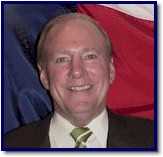
|
| Dick Schulze |
Ken Gordon had to go through this process, including testimony at hearings, for three separate congressional committees. To get everybody's attention, he organized several hundred supporters to write letters and get petitions signed by several thousand voters. These supporters, in turn, influenced the media and started a lot of what is known as buzz. All of this is an awful lot of work, but there is one thing about this case that can make us all proud. Not once did a politician suggest a campaign contribution was essential in this matter.
In time, ownership of the Park did in fact migrate from the Commonwealth to the U.S. Department of the Interior, hence to the National Parks Service. Everyone agrees it has been well managed, and increasing droves of visitors come here every year. It is now clearly a national treasure. Unfortunately, the encampment area got away and has been commercially developed, although not nearly as high-rise as originally contemplated. Along the way, many discouraging words were spoken about the futility of fighting against such odds. The outcome, however, is the embodiment of two slogans, the first by Ronald Reagan. "It's amazing what can be accomplished, if you don't care who gets the credit for it." The other slogan is older, and Quaker. All you need, to accomplish anything, is leadership. And leadership -- is one person.
One day Ken Gordon, the very busy doctor, was asked how much of his time was taken by this effort. His answer was, ten hours a week, every week for five years.
Frederick Mason Jones,Jr. 1919-2009
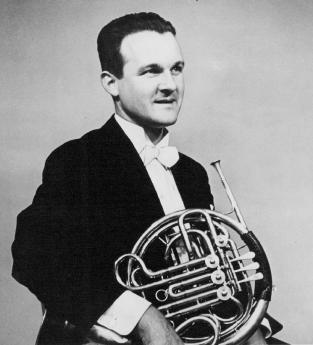
|
| Mason Jones |
Classical music, however else it may be defined, strongly implies music played by an orchestra, or at least a group of musicians. It thus should be no surprise that the members of a famous orchestra bond together for most of their lifetimes in a sense far beyond the ordinary meaning of teamwork. If you are good, really, really good, you will come to the orchestra as a boy, devote every hour of every day to the orchestra, and step down only as a famous old man when you sense that reaction times have slowed. You sit together, travel together, rehearse together, and talk a language of detail which no one else can fully comprehend. Mistakes that one of you made forty years ago in performance, are still joked about because your colleagues know you still feel the pain of it, just as they share their own infrequent but no less fully remembered, moments of failure, largely unnoticed by the audience. When one of your colleagues dies, you turn out by the hundreds for the funeral. And when the hymns are sung, the organist is ignored, struggling to keep up with the people who really know music.
Mason Jones attended the Curtis Institute, itself a collection of prodigies, and was hired by Ormandy after a single audition; a year later he took the position of a first horn and kept it until he finally sensed he was passing his prime and laid it down. He was featured in the many recordings which defined the orchestra, and the Philadelphia Woodwind Quintet. He sometimes recorded as a soloist, but he thought of himself as an orchestral horn player, teaching orchestral horn at the Curtis to many generations of aspirants. He even conducted a little, usually in small groups. His comment on that was that it doesn't take much to be a conductor. "Just ask any orchestra player." At his funeral, it was related that the second horn once had two solo passages repeated within a larger piece, but when its time came there was silence. The second time around, it was played faultlessly. Afterward, Mason was asked what happened. "Fell asleep," he answered. And the second time? "I just played it for him."
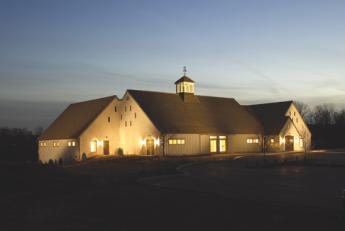
|
| St. Peter's in the Great Valley |
Mason's funeral was held at St. Peter's in the Great Valley, illustrating that strange combination of artistic prodigies with modest beginnings, and the highest of high society, who mix together to create a great orchestra. A very well-groomed lady was heard to remark that this was where she had her coming-out party. St. Peters was founded as an Anglican mission church in 1700 in the Welsh Barony, built a log cabin church in 1728, replaced it with a little white jewel of a church in 1856, and added new buildings in the past few years to accommodate the population growth in the valley. The church has abundant well-tended land, sited on a hilltop surrounded by high hills, quite suitable for a college or private school campus. The homes in the area are a step beyond splendid, hidden in the wooded countryside. Unless you know precisely where to go, the tangle of country roads will defeat you. But the arterial of U.S. 202 is only a few miles away, and Philadelphia's silicon valley nestles beside the highway, inevitably closing in on the countryside. There will be horses and kennels and fox hunts in the region for another decade perhaps, but the new world is moving in on the old one, from all directions.
Ardrossan Wayne PA
Ardrossan, the home of the Montgomery family, covers two square miles of Main Line real estate.
Greenhouses

|
There are lots of mundane activities involved in having a prize show garden, like compost heaps, cold frames, mud rooms, and the like, which competitive show-gardeners never think of talking about, let alone putting on display. However, someone who feels very competitive about the garden usually lets that competitiveness spill over into the greenhouse. Most working greenhouses are muddy and disreputable-looking. When you see a big greenhouse with a spotless floor, however, you know you are learning something about the owner. When tidiness extends to spotless tools and well-sharpened pencils, there's a message. This greenhouse is not merely a tool shed, it's part of the display.
Let's talk about three outstanding greenhouses in the Philadelphia region which are adjuncts to three outstanding horticultural competitors. To spare the feelings of all concerned, the names of the owners will not be mentioned. In one case, the plants are preponderantly indoor plants, a second one is preponderantly filled with outdoor plants, and the third is full of rarities.
The greenhouse full of indoor plants reflects an owner who primarily competes in flower shows in that type of plant, it is true. But this lady obviously brings the flowers to a peak of perfection and then shifts them into the house. The result is a dining area with twenty-five potted flowers scattered tastefully around, dressing up the house. One presumes the flower pots go back to the greenhouse when they start to wilt a little, and probably an effort is made to have plants which flower at different seasons of the year. Back out in the greenhouse, there are dozens of blue ribbons arranged within picture frames to produce pleasing arrangements in themselves. Although this is a famous horticulturalist of long standing, the blue ribbons on display are only awards from fairly recent shows.

|
The second greenhouse to be mentioned is primarily devoted to outdoor plants, being bred and hybridized in controlled circumstances. The owner has created a garden in the interior of a suburban block on the Main Line, and although the houses are all part of the estate, the effect is one of the certain types of plantings in several backyards, a set of sculpted topiaries in one, a formal arrangement of boxwood designs in another, annuals in another. Although the rotation of plantings back and forth from the greenhouse is here probably more of a one-way trip, essentially the greenhouse is serving the same function as the one servicing the indoor display, a place to nurture plantings which are not quite ready for prime time.

|
And the third greenhouse is primarily run by a husband and wife team of horticultural competitors. The other two gardens look as though they employed a dozen or so gardeners, while this one looks like it supports a two-person hobby. It contains a most unusual fern with its own nickname, and dozens of other display specimens of rare and unusual plants to compete in specialty shows of particular varieties. This greenhouse is just as spotless as the ones with much larger staff to do the cleaning, but it seems to have a wider variety of gardener conveniences to lighten the load and increase productivity. One quickly senses that the husband of the team pores over greenhouse catalogs and quickly adopts labor-saving devices. Space is at a premium in this greenhouse, and one guesses its results as much from a need to conserve steps as to conserve space. The effect faintly starts to resemble the jam-packed cockpit of a space-ship.
One technology advance seems to be so superior they all have it. The exterior surface of the greenhouses is not made of glass, but of polycarbonate plastic, sometimes known as "bullet-proof glass". Greenhouses seem a safe enough use for polycarbonate, although widespread use in disposable plastic water bottles seems a more questionable direction for environmental enthusiasm. This transparent material admits the light of a much wider wavelength, particularly ultra-violet, and no doubt greatly extends the season and the effectiveness of indoor nurture. From the photographer's point of view, the resulting pictures are far more pleasing, with diffused light and greater color brilliance. Thus, science has finally achieved for the Philadelphia region the same striking color of light that was so attractive to French Impressionists in southern France, and to vacationers in Hawaii.
The other thing this plastic invention has done has been to increase the general attractiveness of greenhouses. Until rather recently, it was the custom to paint white-wash on the glass and let it slowly weather away as increased sunlight is needed for the plants. Thus, greenhouses once almost always looked shabby and disreputable; not a place you would want seeing by visitors. But nowadays, you just keep them spic and span. And hold a cocktail party there.
REFERENCES
| Standardized Plant Names: American Joint Committee on Horticultural, Frederick Law Olmsted | Google Books |
John Bogle, A Prophet In Our Valley
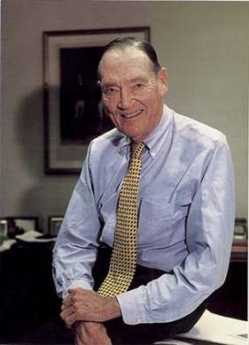
|
| John C Bogle |
Those who never met a living legend would have found in John C. Bogle a good place to begin, 80-plus years old, lively and very charming. The Vanguard Investment Company, which he founded, provides him a little think tank office, out of which have come several books and many articles (somebody else is running the company, now.) The drift of most of what he writes and most of his testimony to Congress, or at awards ceremonies, is that mutual funds charge too much. When the press decides to feature him, the spectacular theme is emphasized that in 1996 this current squash and tennis player was just about dead, and had a transplant of someone else's heart to keep him going. A populist graduate of Pre-Vietnam Princeton, and also the embodiment of a medical miracle, now, those things are newsworthy.
Future students of finance, however, will regard those things as minor footnotes. Bogle's real achievement was the invention of the index fund. Indexing had two purposes and probably stumbled onto a third. It combined diversification, low administrative costs, and outstanding investment performance in a single security. There will be foot-dragging in the boutiques and bucket shops, but this invention is well on its way to converting investment management from an inefficient luxury of the rich into an affordable efficient commodity for everybody. You will know that a fundamental has been established on the day when the U.S. Government starts buying index funds, or at least when it permits them to help finance Medicare or Social Security. Such invested funds of a government qualify for the term Sovereign-wealth funds; in fact, since major problems can be imagined if governments start to vote common shares, Heaven helps us if they don't stick to index funds. The investment community already knows that something basic has arrived, by their own standards. The original index fund will soon have a trillion dollars invested in it. Just do the math on what you would be paid if you realized a fifth of one percent, year after year, on managing a trillion. And then reflect on the impact on transactional costs generally, when many eminent firms still charge five times that much. To make barrels of money and still be a hero for making your product remarkably cheap -- now, there's a Philadelphia dream.
A technical explanation. Five hundred stocks as one lump are cheaper to buy and sell as a "program trade", and perform more smoothly, than any of them individually, because the ups balance out the downs. Transaction costs are less, because there is hardly any switching among the 500 stocks by the committee in charge, and therefore few taxes to pay. Fine, but what might not be easily anticipated is that the lumped investment performs better, unmanaged than the vast majority of funds managed by experts. Large funds, at least, are forced to buy the
stocks of large corporations. Large corporations are inherently subject to immense scrutiny and publicity, so there remains little advantage to being on the inside or acting quickly on general economic news. What everybody knows, in Wall Street parlance, isn't worth knowing. Index funds made up of small companies, or foreign companies, may possibly not work out as well as those limited to large domestic companies. For a while, it was thought index funds would out-perform when everything in the marketplace was going up, but underperform when most things were going down in a bear market. Not so, they seem to work better any way you look at them. They are the standard for performance, not just a measure of the averages. These things are here to stay.
Well, maybe. Reservations remain, although they don't have much to do with investment choices. It may take decades to happen, but it's hard to escape the uneasy feeling that some manager, someday, will figure out a way to divert a hundredth of a percent, or so, into his own pocket. A hundredth of a percent of a trillion dollars is quite a temptation. Perhaps an even more serious concern is that voting control of the corporations in the portfolio inevitably gets diluted by widespread index investing. Management supervision by stockholders is potentially lessened. Whether this will lead to management abuses, a temptation for minority stockholder intrusions, or to the government over-regulation, taking any of these directions would likely create a new power balance in the economy.
Meanwhile, John Bogle, who died on January 16, 2019, is on his way to financier sainthood. He's certainly in a class with Anthony Drexel and Nicholas Biddle, already. And other icons are under review.
Founding Fish

|
| Potomac |
In 2002, John McPhee brought out a perfectly splendid book about fish and fishing history in this region, with particular emphasis on shad. He makes the whole topic remarkably interesting, but you have to be a little wistful about the way he demolished a splendid story of fish in Philadelphia during the Revolutionary War. The book is called The Founding Fish.
As everyone knows, George Washington and the Continental Army were starving and freezing at Valley Forge, a few miles up the Schuylkill, while Major Andre and the other British officers were cavorting downtown with the Tory ladies, grr. The story has long been told that things got to a desperate state at Valley Forge when, lo, the annual shad run was several weeks early and mountains of fish came roaring up the river to the excited shouts of the starving patriots and rescued the raggedy starving Continental Army. It would make a wonderful scene in a movie.
McPhee tells us that George Washington was in fact a shady merchant, having caught and pickled many barrels of shad coming up the Potomac River. The annual shad excitement was no news to him, and it seems quite possible he selected the campsite at Valley Forge with this spring event in mind. Shad was no news to the British, either; there are records of their trying to block off the Schuylkill with nets to prevent the fish from getting upriver to Valley Forge.
Unfortunately, a careful search of letters and records fails to record any shad run earlier than April that year. The rescue of song and story does not appear in contemporary documents. What's more, some unnecessarily diligent scholars have sifted through the garbage heaps of the encampment area, and have only found pig and sheep bones, no shad bones.
Those graduate students undoubtedly deserve to be awarded degrees for their work, especially the digging in garbage part. But nevertheless, it all does seem a pity to ruin a good story that way.
Rebel Hill
The Schuylkill River, hence Schuylkill Expressway and also Amtrak, all take a big bend westward about ten miles from Philadelphia. They are making a detour around a big hill or minor mountain, tending to position the sun in the eyes of many commuters at certain hours of the day. Real estate developers are apparently responsible for naming the place Rebel Hill, and it's getting pretty crowded with houses. The Rebel they had in mind was George Washington.
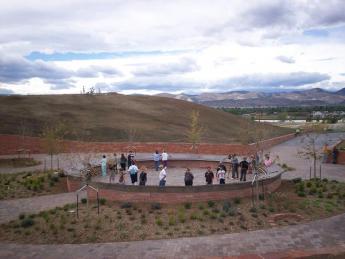
|
| Rebel Hill |
The father of our country was in retreat from the battle of Germantown, having crossed the river at Matson's Ford, then following Matsonford Road over and beyond the big hill, and pausing for water at the spring in the gulch formed by Gulch Creek, now more decorously called Gulph Creek. The creek tumbles down the side of a long ridge forming the south side of the Great Valley; the gulch or gulf is really a crevasse in that ridge, which in a sense makes Rebel Hill just a split-off extension of that ridge. Consequently, the gulch makes a water-level route from the Schuylkill to Valley Forge, which anyone would take to get there in a hurry. Valley Forge is a misleading term; it's a hill in the middle of the Great Valley, as the center of an angel food cake tin, and was thus defensible in all directions. The cleft in the southern ridge is where you would normally travel to get to the base of the bastion of Valley Forge.
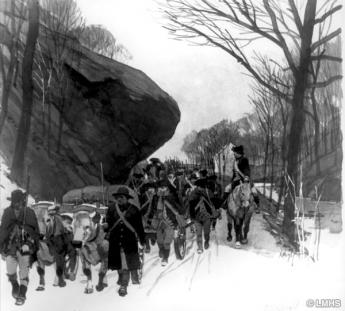
|
| Old Gulph Road |
So, everyone still takes that route, following Montgomery Avenue after it turns into South Gulph Road, but before it turns into North Gulph Road. The road up along the southern ridge is called Old Gulph Road, while the newer extension from the river is called New Gulph Road. All of these winding roads are compressed within the narrow defile beside Gulph Creek, reachable by splashing through the fords in the creek, although that is discouraged after ice forms in the winter. And, yes, a new road has come in at a restored old farmhouse, called New Gulph Road. The restoration has created a fancy restaurant, which somehow forgets that at the time we are talking about, it was the headquarters of (Major) Aaron Burr. The giant highway cloverleaf ahead on South Gulph Road tends to obscure the fact that it was the direct road to Valley Forge, now further obscured by lots of shopping center. If you persist and keep a lookout for the street signs, you will eventually get to the Memorial Arch, log cabins and National Park Service facilities of Valley Forge.
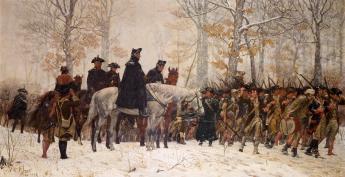
|
| Valley Forge |
Back in the gulch, however, is the spring where Washington's troops refreshed their canteens. Just beyond it is a great big rock, much mentioned in memoirs of the episode. Around 1950, the highway engineers decided to blast this rock out of the way of widening a road that badly needs widening. The Daughters of the American Revolution saved the day. Creating a giant fuss, the DAR succeeded in limiting the engineers to chiseling the bottom of the rock away. A gentleman in his eighties recently remarked he had driven past that rock thousands of times, and always wondered what it was there for. Now he knows.
Main Line Oligarchy
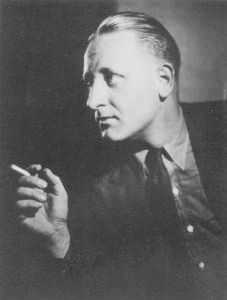
|
| John Gunther |
"In the Philadelphia suburbs, set in an autumnal landscape so ripe and misty that it might have been painted by Constable....lives an oligarchy more compact, more tightly and more complacently entrenched than any in the United States, with the possible exception of that along the North Shore of Long Island....The Main Line lives on the Main Line all year around...It is one of the few places in the country where it doesn't matter on what side of the tracks you are. These are very superior tracks.....What does the Main Line believe in most? Privilege."
John Gunther -- Inside U.S.A.
Fort Washington, PA
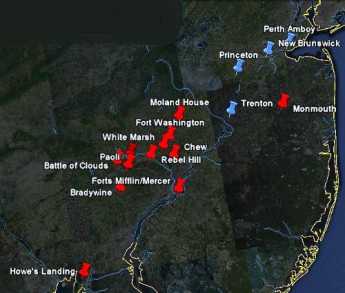
|
| British Campaigns |
The Revolutionary War lasted eight years, so there are a half dozen Fort Washingtons, in several states. Pennsylvania's Fort Washington gets free advertising from being a stop on the Pennsylvania Turnpike at the intersection of the East-West branch and the North-South branch, near some very large shopping malls. Nevertheless, the suburbs haven't reached it yet, and it is on a series of wooded mountain ridges discouraging housing development. Another way of describing its location is that it is several miles north of Chestnut Hill along the Bethlehem Pike, a road which begins in the center of Chestnut Hill at Germantown Avenue. The Pike is quite old, with many surviving colonial-era houses and inns to liven up the trip.
A third way to describe Fort Washington is that the headquarters were at the point where Bethlehem Pike crosses the Wissahickon Creek. How's that again? How does the western Wissahickon Creek then flow uphill to Chestnut Hill? Of course, it doesn't, but the appearance takes some explaining. The northwestern end of Philadelphia is reached by two ancient roads running on ridges quite close together like the split tail of a fish. Germantown Avenue runs up one ridge, and Ridge Avenue runs up the second ridge closer to the Schuylkill. The Wissahickon runs in the gully between these two ridges and tumbles down the hill at Wissahickon Avenue, or Rittenhousetown if that is more understandable. The ridge of Ridge Avenue is essentially cut off by the creek, but engineers have put Ridge Avenue on a high arching bridge as it crosses the creek far below, and by this magic Ridge Avenue and Germantown Avenue are at about the same height most of the way. The Wissahickon Creek is really running downhill the whole way, but sort of disappears from sight and reappears as it twists through the gorges, misleading the casual visitor (or commuter). As happened so often during the Revolutionary War, Washington showed his understanding here of geography in the service of guerrilla warfare.
Since the British were headquartered in Germantown, and the Americans have camped a few miles away on the same creek, it was inevitable there would be some sort of battle in the region. Washington launched a three-pronged attack on the British soon after arriving at Fort Washington, but his troops fired at each other in the fog, and apparently, two prongs more or less got lost in the gorges. The Americans retreated, and the British consolidated their conquest of Philadelphia. They did launch one surprise attack on the American encampment (the Battle of Whitemarsh), but that was mainly a reconnoiter, given up after a few days when it became clear Washington's troops held the high ground. It really is high ground (hawk-watching platforms and all) for reasons already stated. Chestnut Hill is a pinnacle sticking up on the west side of the Creek, with the Wissahickon snaking around its base.
This really was a perfect place for Washington to aim for after the Brandywine Battle, close enough to threaten the British, located in a bowl-like valley for camping, but terminating at the top of a mountain ridge in case the British counter-attacked. And with plenty of running water from the Wissahickon. However, it was a little too close for comfort, and he withdrew across the Schuylkill into Valley Forge as a more substantial natural fortress. Valley Forge is also on a hilltop, but one sitting in the middle of the Great Valley (Route 202 to Wilmington), as the center of an angel food cake tin. No doubt, the advantages of this new location became evident to him at the earlier skirmishes of the Battle of the Clouds, and the Paoli Massacre, which occurred nearby.
In retrospect, these maneuvers and skirmishes were of little military significance, except for the major Battle of Brandywine. The lost opportunity was the chance to catch the British Army without supplies or access to the Navy, aborted by what was probably a hurricane, the so-called Battle of the Clouds. Philadelphia was lost, and the opportunity to win the war early by smashing a third British army was gone for good. The defeat of the Hessians at Trenton, the loss of Burgoyne's army at Saratoga, and a victory on the outskirts of Philadelphia might together just have finished the War. But things didn't work out, the British similarly missed some opportunities, and the war was to last another five years. Once the French allied themselves, their wealth and naval strength tended to make French priorities dominate strategy.
Nevertheless, a perfectly splendid tourist trip awaits the history buff who travels from Elkton, Maryland, where the British landed, to the Battle of Brandywine battlefield, up the Great Valley to Immaculata University where the Battle of the Clouds took place, over to the Battlefield of the Paoli Massacre, crossing the Schuylkill and going to Whitemarsh, then to Fort Washington, and back up Bethlehem Pike to Germantown Avenue, and down to the Chew Mansion. The campaign for the conquest of Philadelphia ended with the fall of Ft. Mifflin when the British fleet was finally able to re-supply Howe's army. This direct auto tour is a little out of chronological sequence, but it can be done in one day if you don't dawdle. If you slow down and spend an extra day, you can include the Moland House where Washington waited to see where General Howe was going. At the right season, there's hawk watching on the ridge at Fort Washington Park, and maybe on to Trenton, or even up the New Jersey waist to Perth Amboy on lower New York Bay, where the Howe brothers began and ended their Philadelphia adventure. That would take you past Princeton and New Brunswick, or even include a trip to the Monmouth Battleground. With this extension, you have traveled much of the extent of the Revolutionary War in the Mid-Atlantic states.
Bones in Duffy's Cut
THE Right Angle Club was recently honored by a talk by Professor William Watson, who teaches history at Immaculata University in Malvern, Pennsylvania. Although it is hard to find much memorial recognition of it, Immaculata is on the site of the Battle of the Clouds, of the Revolutionary War. Washington's army was retreating from the advancing British invaders from Elkton, Maryland, who were headed for the occupation of Philadelphia, in 1778. Although Washington had been outflanked at the biggest battle of the war at Brandywine Creek, he regrouped near Paoli and prepared to defend Philadelphia where the Continental Congress convened. A tremendous rainstorm, possibly a hurricane, hit the two armies as they formed for battle, and everyone's gunpowder was soaking wet. By mutual consent, the battle was called off. The Malvern area was also the site of the Paoli massacre, where General Anthony Wayne overestimated his understanding of the local area, and British troops attacked at night with orders to use bayonets, only.
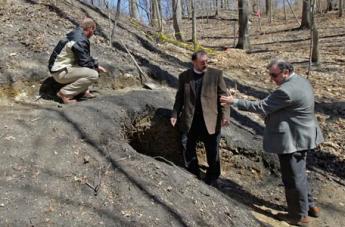
|
| Duffy's Cut |
Professor Watson was, however, speaking about another massacre in the area, at Duffy's Cut. The Cut now belongs to Amtrak, but it was originally built in 1832, from Columbia on the Susquehanna River eastward, as the Philadelphia and Columbia RR, using horse-drawn rail carriages. That essentially means it went from Scotch-Irish Cumberland County, through the Pennsylvania Dutch territory, to Quaker Chester County and Federalist Episcopalian Philadelphia. The builders of the railroad contracted out mile-long sections of the construction to contractors, one of whom was Philip Duffy, who naturally imported southern Irish laborers to do the digging. As a sidelight, Duffy lived in Port Richmond, where he was buried, allegedly a very rich man. His work site was nearly 60 miles east of Columbia, the most expensive contract on the railroad because it involved more cutting and filling of the hilly countryside: Duffy's Cut.
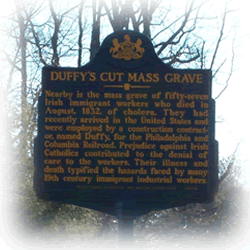
|
| Duffy's Cut Marker |
Sanitary conditions at the dig site were probably pretty primitive, ideal for the spread of fecal-borne illnesses like cholera (and hepatitis, amoebic dysentery, Salmonella, and Shigella), which are characteristic of concentration camps, prison camps, army encampments, and the like. Many later epidemiologists now trace the introduction of cholera to Canada, with downward spread along the Susquehanna, but fifty years before Pasteur there was no sure way to make the diagnosis and no knowledge of its epidemiology. The Irish encampment at Duffy's Cut might just as well have died of bacillary dysentery, but it would have made little difference to know; they just died, and it was said to be cholera that did it. It was probably some kind of fecal contagion, but modern archaeology has recovered eight or ten skulls with bullet holes at the site, and historical investigation of the more usual type has recovered letters by President Clement of the Pennsylvania Railroad, ordering a cover-up. The rest of the story is necessarily conjectural, and we have to be uncertain whether Clement was concerned about hushing up cholera in the region, or ethnic riots, and if so whether he wanted to avoid scaring away replacement laborers, or avoid stirring up local antagonisms. Professor Watson describes considerable difficulty with getting cooperation from politicians and news media in pursuing his studies, where it is hard to see any non-railroad motive, except the motive of wanting to let sleeping dogs lie.
If so, it is a serious concern. It must be recalled that the Scotch-Irish of central Pennsylvania were located there as a result of the activities of James Logan, the agent of the Penn family. The Penns wanted to sell land to settlers and felt that fear of hostile Indians was inhibiting immigration. Logan, who was himself a Scot from Northern Ireland, suggested that the protestant Scotch Irish of that region were tired of combating their Catholic neighbors to the south, and were definitely the equal of the Indians in combativeness. This is the reason the Scotch Irish of Pennsylvania were located to the west of the German settlements of Dauphin and Lancaster Counties. It is also the cause of numerous clashes with the Indians (the Paxtang Boys), the Connecticut invaders of the three Pennamite Wars, and most notably -- the Irish Catholic Molly Maguires of the Pottsville region. Throughout all of these overtly military disputes ran the readily observable fact that the Scottish tribes were accustomed to guerrilla warfare in the woods. They mainly are responsible for winning the Revolutionary War, at least in the Appalachian regions stretching as far to the south as Georgia. They leave us a heritage of bagpipes, country music, very rough football, and airplane pilots. Unfortunately, rough behavior provokes rough behavior in return, and much of the unfortunate features of the labor conflicts of our national politics can be traced to the scars and antagonisms of the Molly Maguire episode of railroads and coal mining. This may or may not have been on Clement's mind when he tried to suppress the news of Duffy's Cut massacre, but it should have been, and to some extent it probably was.
There is no excuse for shooting people in the head or killing them with an ax. But the sixth or seventh generation descendants of the victims are urged to reflect that a campful of male laborers far away from home are apt to exhibit unfortunate behaviors. Remember that no one knew the cause of cholera, but it was new, and it certainly looked contagious. The laborers may or may not have brought it with them, but somebody introduced it to the region, and it looked as though the contagion would continue to spread as long as the laborers continued to be there. There might well have been some unfortunate economic incentives at work, like the disappearance of the Conestoga wagon industry among the Pennsylvania Dutch when the railroad came through. And the obvious concern of the railroad owners that the region has a peaceful, healthful, reputation. The almost total approval of slavery by the Pennsylvania Irish during the Civil War provoked Lincoln to send ten thousand troops to the area during the Civil War. And on, and on. There is almost no part of this region which does not have some remote history of savage behavior. Let's be careful not to stir it up.
American Chestnut Trees
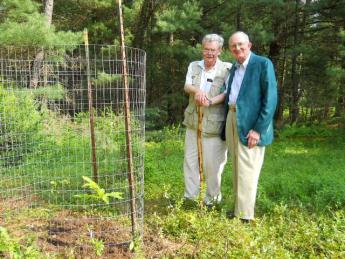
|
| American Chestnut tree |
RECENTLY, John Wenderoth of the Tyler Arboretum visited the Right Angle Club of Philadelphia, bringing an astounding account of the triumph, near-extinction, and revival of the American Chestnut tree. The Tyler Arboretum, and this man, in particular, is at the center of the movement to rescue the tree, although the modern Johnny Appleseeds of the movement seem to be a Central Pennsylvanian named Bob Leffel, and a geneticist named Charles Burnham. Together, they had the vision and drive to enlist a thousand volunteers to plant seedlings in Pennsylvania; and there are many other volunteer groups in other states within Appalachia. About 45,000 Chestnut hybrids have been planted, surrounded by wire fencing to protect the new trees until they grow too tall for deer to reach the leaves. Here's the story.
In 1904 it was estimated that a fourth of all trees in the Eastern United States were American Chestnuts. The tree typically grew to eighty feet before permanent branches took over, so the shading and tall pillars of tree trunks gave the forest a particular cathedral-like distinctiveness, much celebrated by such authors as James Fennimore Cooper. The wood of the American Chestnut tree is rot-resistant, so it was favored by carpenters, log-cabin builders, and furniture makers. It once was a major source of tannin, for leather tanning. The nuts were edible, but it has been a long time since they were available for much eating. The chestnuts you see roasted by sidewalk vendors are primarily Chinese Chestnuts, which actually come to us from South Korea. The Buckeye, or horse chestnut, produces a pretty and abundant nut but is too bitter for most tastes. For whatever reason, a fungus was first discovered to infect the chestnuts of the Bronx Zoo in 1905, attracting the attention of Teddy Roosevelt and his Progressive naturalist friends, but to little avail. The fungus (Cryptomeria parasitic) enters the tree through cracks in the bark, flourishes in the part of the tree which is above ground, leaving the roots undisturbed. Ordinarily, when this sort of thing happens, the roots send up shoots which keep the tree alive and flourishing. Unfortunately, the abundant deer of this area quickly nipped off the shoots as they appeared, and finally, the trees died. It took only a decade or so for this combination of natural enemies to wipe out the species, and today it is unusual to see lumber from this source. The forests of Chestnuts have been replaced by other trees, mostly oaks. The Chinese chestnut, however, proved to be resistant to the fungus, even though it does not grow to the same height.

|
| Chinese Chestnuts |
After many futile but well-meaning efforts to save the trees by foresters, friends of the American Chestnut tree turned to geneticists. The goal was to transfer the fungus resistance gene from the Chinese Chestnut to a few surviving American Chestnuts. It took six or seven generations of cross-breeding to do it (four generations of seedlings, then crossing the crosses, then weeding out the undesirable offspring), but eventually, the Tyler Arboretum was supplying truckloads of seedlings to the volunteers to plant in likely places. It's going to take many years for the seedlings to grow in sufficient numbers to make an impact on our forests, and eventually on our carpenters, but that effort is underway with gusto. If anyone wants to volunteer to join this effort, there appears to be room for plenty more people to help.
| Posted by: Robert Hansell | Aug 5, 2012 11:10 PM |
| Posted by: Sunshine | Jan 3, 2012 10:53 AM |
23 Blogs
Chester County, Pennsylvania
 When you say Chester County, you are probably talking about horses. There's much more to say.
When you say Chester County, you are probably talking about horses. There's much more to say.
Pennyslvania's Boundary: David Rittenhouse, Hero, Lord Baltimore, Villain
 Because a local genius invented and perfected surveying instruments, America is one of the few nations in the world with straight-line boundaries.
Because a local genius invented and perfected surveying instruments, America is one of the few nations in the world with straight-line boundaries.
Boundaries of the Grant of Pennsylvania
The land granted to Penn was mostly swamp and wilderness in the 17th Century. Infinite disagreements were certain to result, but a paragraph described all that could be known at the time of the grant.
The Quaker Who Would Be King
Two Americans, Josiah Harlan, and George Bush conquered Afghanistan, and for centuries others who tried it got massacred. Harlan, a Chester County Quaker farm boy with more brazenness than Alexander the Great, died in San Francisco while impersonating a physician.
Forming the State of Delaware
 In 1632, King Charles I granted to the Maryland proprietor coastal land with a northern border at the 40th parallel. In 1682, his son James the Duke of York evicted the Dutch from the Connecticut River to Cape Henlopen; afterward, his brother King Charles II gave away New Jersey and Pennsylvania, leaving York with New York plus a strip of wilderness from Pennsylvania to Henlopen. York then gifted that southern strip to William Penn before anyone realized there was a sloppy overlap with Maryland of thousands of square miles. Lawsuits are galore.
In 1632, King Charles I granted to the Maryland proprietor coastal land with a northern border at the 40th parallel. In 1682, his son James the Duke of York evicted the Dutch from the Connecticut River to Cape Henlopen; afterward, his brother King Charles II gave away New Jersey and Pennsylvania, leaving York with New York plus a strip of wilderness from Pennsylvania to Henlopen. York then gifted that southern strip to William Penn before anyone realized there was a sloppy overlap with Maryland of thousands of square miles. Lawsuits are galore.
Defeat and Disaster: Philadelphia Falls to the Enemy

Furniture for the Horse Country
 Fine art is generally the product of rich people demanding something special from a nearby artisan community. Furniture making in Chester County is sort of like that.
Fine art is generally the product of rich people demanding something special from a nearby artisan community. Furniture making in Chester County is sort of like that.
Doing Well, Doing Good.
 A board member of Rotary International recently ran an Afghanistan relief program and wrote a novel about the Battle of Brandywine. He's a Quaker, lives on a farm, and is chairman of the boards of several organizations.
A board member of Rotary International recently ran an Afghanistan relief program and wrote a novel about the Battle of Brandywine. He's a Quaker, lives on a farm, and is chairman of the boards of several organizations.
Gardens for Posterity
 New flowers can be planted each year, but forests take generations to grow. What you plant depends on who is meant to look at the result.
New flowers can be planted each year, but forests take generations to grow. What you plant depends on who is meant to look at the result.
Dog Days
 Hunting rabbits with a pack of French hounds scarcely sound like a matter to agitate the Pennsylvania Legislature and its Governor, so maybe something else is afoot.
Hunting rabbits with a pack of French hounds scarcely sound like a matter to agitate the Pennsylvania Legislature and its Governor, so maybe something else is afoot.
Serpentine Rock From Serpentine Barrens
 Nice green serpentine stone was a popular building material until its disadvantages were recognized.
Nice green serpentine stone was a popular building material until its disadvantages were recognized.
Military School
 Valley Forge Military Academy takes rambunctious boys and makes them into leaders. Even some of the misfits and dropouts seem to benefit from the difficult experience.
Valley Forge Military Academy takes rambunctious boys and makes them into leaders. Even some of the misfits and dropouts seem to benefit from the difficult experience.
Kenneth Gordon, MD, Hero of Valley Forge
 This soft-spoken child psychiatrist was mainly responsible for keeping real estate developers from building houses all over the Valley Forge encampment.
This soft-spoken child psychiatrist was mainly responsible for keeping real estate developers from building houses all over the Valley Forge encampment.
Frederick Mason Jones,Jr. 1919-2009
 The French horn of the Philadelphia Orchestra, played by the acknowledged premier artist in the history of brass instruments, falls silent.
The French horn of the Philadelphia Orchestra, played by the acknowledged premier artist in the history of brass instruments, falls silent.
Ardrossan Wayne PA
The Philadelphia Story was about the Main Line heiress, a real one, in fact. But when Hollywood came to film the story, they took one look at her house, blanched, and selected something smaller.
Greenhouses
 A greenhouse is a greenhouse, until you know something about them.
A greenhouse is a greenhouse, until you know something about them.
John Bogle, A Prophet In Our Valley
 John Bogle invented the index fund. Lower cost, better performance.
John Bogle invented the index fund. Lower cost, better performance.
Founding Fish

Rebel Hill
 Everybody knows Washington's troops retreated to Valley Forge, but not everybody realizes how he got there.
Everybody knows Washington's troops retreated to Valley Forge, but not everybody realizes how he got there.
Main Line Oligarchy
 Apparently, the Main Line offended John Gunther.
Apparently, the Main Line offended John Gunther.
Fort Washington, PA
 Fort Washington PA was never much of a fort, and nothing of it remains to be seen. Rather, it was mostly a large campground north of Philadelphia between the Battle of Brandywine and the Battle of Germantown. An interesting visit, nonetheless. A side-visit to Hope Mansion would add some local color.
Fort Washington PA was never much of a fort, and nothing of it remains to be seen. Rather, it was mostly a large campground north of Philadelphia between the Battle of Brandywine and the Battle of Germantown. An interesting visit, nonetheless. A side-visit to Hope Mansion would add some local color.
Bones in Duffy's Cut
 They are digging up bones in Malvern, finding evidence of murder. Some people are uneasy about perpetuating ethnic strife.
They are digging up bones in Malvern, finding evidence of murder. Some people are uneasy about perpetuating ethnic strife.
American Chestnut Trees
 Scarcely a century ago, American Chestnut trees were a quarter of all trees in America. Now, they are almost all gone, but a thousand volunteers are trying to rescue them.
Scarcely a century ago, American Chestnut trees were a quarter of all trees in America. Now, they are almost all gone, but a thousand volunteers are trying to rescue them.